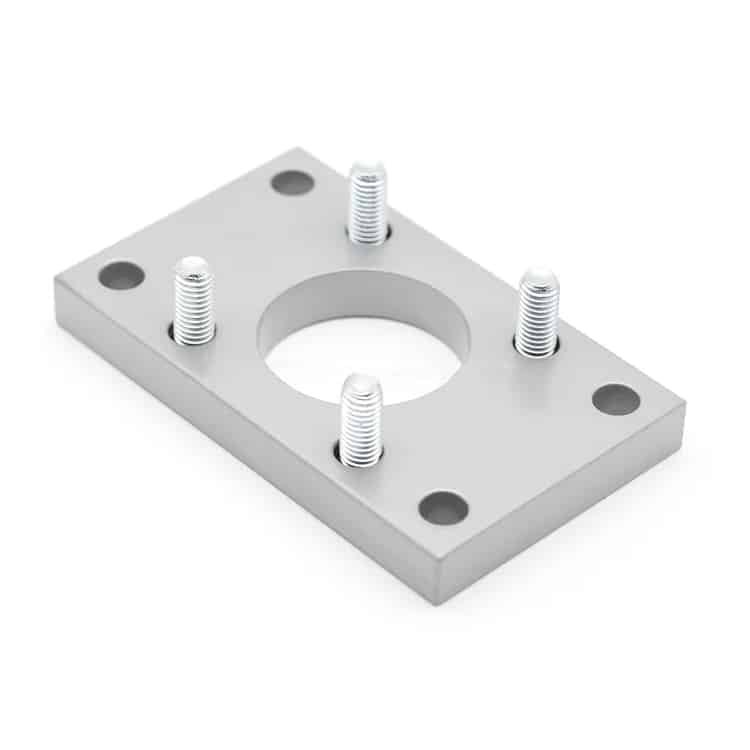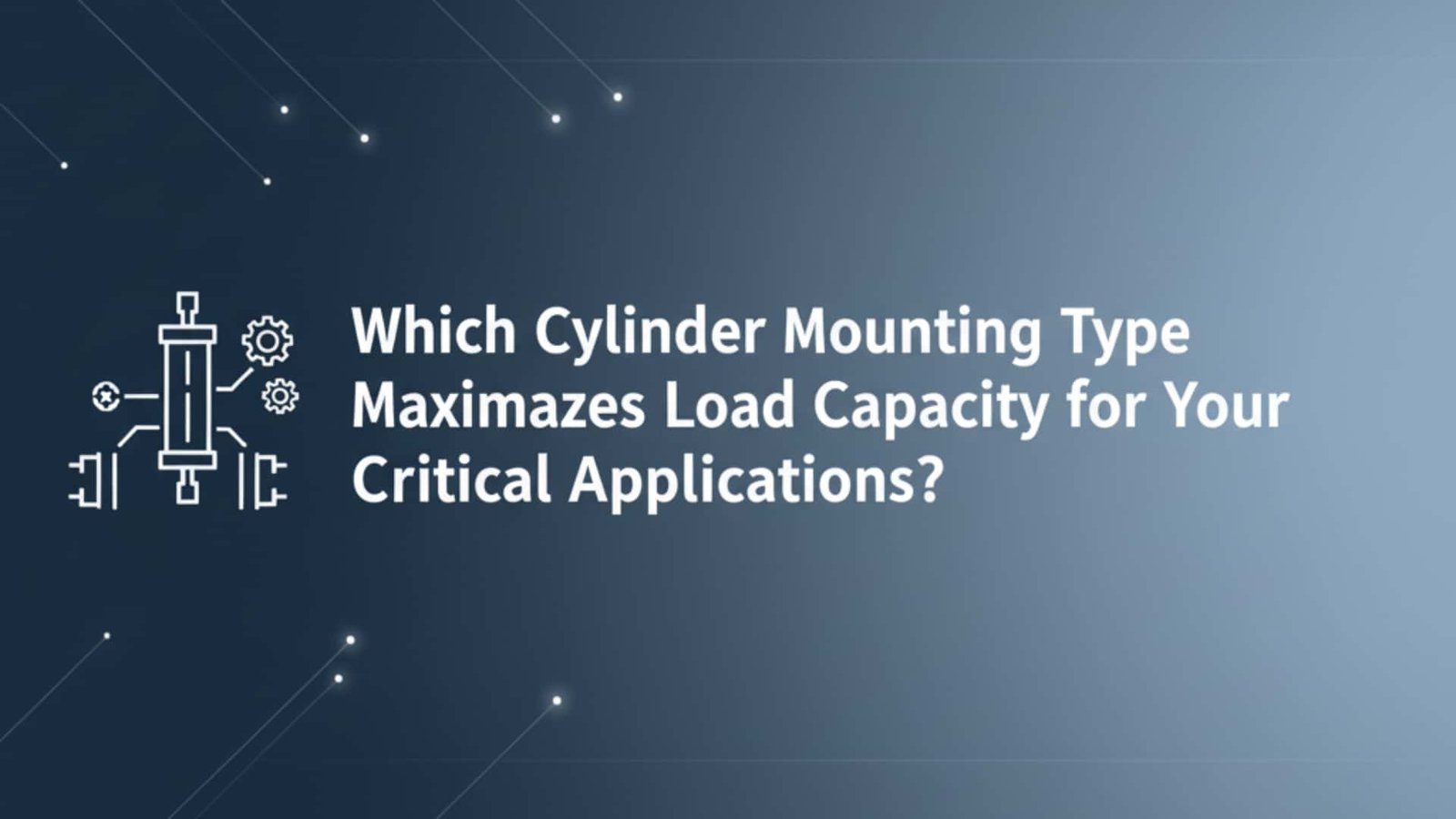
Engineers lose over $1.2 million annually due to premature cylinder failures caused by improper mounting selections, with 45% choosing fixed mounts for dynamic loads that require pivot mounts, while 38% select lightweight trunnion mounts for heavy-duty applications where they fail within months instead of years. ⚠️
실린더 마운팅 유형은 최대 15,000N의 축 방향 하중을 처리하는 고정 마운트, 8,000N의 측면 하중을 지원하는 피벗 마운트, 좁은 공간에서 12,000N을 관리하는 트러니언 마운트, 고강도 애플리케이션에 20,000N 이상의 용량을 제공하는 플랜지 마운트 등 부하 용량을 직접 결정하므로 적절한 선택은 고비용의 장애를 방지하고 시스템 안정성을 극대화하는 데 매우 중요합니다.
Just last month, I worked with Jennifer, a mechanical engineer at a steel processing plant in Pennsylvania, whose cylinders were failing every 6 weeks due to 사이드 로딩1 on fixed mounts. After switching to our Bepto pivot-mounted cylinders, her system has operated flawlessly for over 4 months with zero downtime. 🏭
목차
- What Are the Key Differences Between Fixed and Pivot Cylinder Mounts?
- How Do Trunnion and Flange Mounts Compare for Heavy-Duty Applications?
- Which Mounting Configuration Provides Maximum Load Capacity for Your Application?
- How Do You Calculate and Optimize Load Distribution Across Different Mount Types?
What Are the Key Differences Between Fixed and Pivot Cylinder Mounts?
Understanding the fundamental differences between fixed and pivot mounts enables engineers to select the optimal configuration for specific load conditions and application requirements.
Fixed mounts provide maximum axial load capacity up to 15,000N with rigid attachment but cannot accommodate side loading or misalignment, while pivot mounts offer 8,000N capacity with ±5° angular flexibility and excellent side load resistance, making pivot mounts essential for applications with dynamic loading or potential misalignment issues that would destroy fixed mount cylinders.

Fixed Mount Characteristics
Load Capacity Advantages:
- 최대 axial force2: Up to 15,000N depending on cylinder size
- Rigid connection: No flex or movement under load
- Simple installation: Direct bolt-on mounting
- 비용 효율적입니다: Lower manufacturing and installation costs
Critical Limitations:
- Zero side load tolerance: Any lateral force causes immediate failure
- No misalignment accommodation: Perfect alignment required
- 스트레스 집중3: All forces transmitted directly to mount points
- Limited application scope: Only suitable for pure axial loading
Pivot Mount Advantages
Flexibility Benefits:
- Angular accommodation: ±5° typical range
- Side load resistance: Handles lateral forces effectively
- Misalignment tolerance: Compensates for installation variations
- Dynamic capability: Adapts to changing load directions
로드 용량 사양:
| 실린더 보어 | Fixed Mount Max Load | Pivot Mount Max Load | 측면 부하 용량 |
|---|---|---|---|
| 32mm | 3,000N | 2,000N | 800N |
| 50mm | 6,000N | 4,000N | 1,500N |
| 80mm | 12,000N | 8,000N | 3,000N |
| 100mm | 15,000N | 10,000N | 4,000N |
애플리케이션 선택 기준
Choose Fixed Mounts When:
- Pure axial loading only
- Perfect alignment guaranteed
- Maximum load capacity required
- 비용 최적화가 최우선
- Static applications with no movement
Choose Pivot Mounts When:
- Any possibility of side loading
- Dynamic applications with movement
- Installation alignment uncertain
- Long-term reliability critical
- Maintenance access is limited
How Do Trunnion and Flange Mounts Compare for Heavy-Duty Applications?
Trunnion and flange mounts serve different heavy-duty applications, with each offering unique advantages for specific industrial requirements and space constraints.
Trunnion mounts provide 12,000N capacity in compact installations with 360° rotation capability and excellent vibration resistance, while flange mounts deliver maximum load capacity exceeding 20,000N with rigid mounting for the heaviest applications, making trunnion mounts ideal for space-constrained dynamic applications and flange mounts perfect for maximum-load stationary installations.
Trunnion Mount Specifications
Design Advantages:
- Compact footprint: Minimal space requirements
- 360° rotation: Complete rotational freedom
- 균형 잡힌 로딩: Forces distributed evenly
- 내진동성: Excellent dynamic performance
Load Capacity by Size:
| 실린더 보어 | Trunnion Max Load | Moment Capacity | 회전 범위 |
|---|---|---|---|
| 40mm | 4,000N | 150 Nm | 360° |
| 63mm | 8,000N | 400 Nm | 360° |
| 80mm | 12,000N | 650 Nm | 360° |
| 100mm | 15,000N | 1,000 Nm | 360° |
Flange Mount Capabilities
Heavy-Duty Features:
- Maximum load capacity: 20,000N+ for large bores
- 견고한 마운팅: No deflection under load
- Multiple bolt patterns: Distributed load attachment
- Custom configurations: Tailored to specific requirements
설치 고려 사항:
- Space requirements: Larger mounting footprint needed
- Alignment critical: Precise installation required
- 유지 관리 액세스: Plan for service requirements
- Foundation strength: Adequate support structure essential
Bepto Mount Solutions
At Bepto, we offer comprehensive mounting solutions:
- Standard configurations for common applications
- Custom mount designs for special requirements
- Load calculation support for optimal selection
- Installation guidance for maximum performance
Robert, a project manager at a automotive assembly plant in Michigan, needed maximum load capacity in a tight space. Our Bepto trunnion-mounted cylinders provided 12,000N capacity while fitting in half the space of his previous flange-mounted solution. 🚗
Which Mounting Configuration Provides Maximum Load Capacity for Your Application?
Selecting the optimal mounting configuration requires analyzing load types, directions, and magnitudes to match cylinder capabilities with application demands.
Maximum load capacity is achieved through proper mount selection: flange mounts for pure axial loads up to 25,000N, pivot mounts for combined axial/side loads up to 10,000N/4,000N, trunnion mounts for rotational applications up to 15,000N, and custom mounts for specialized requirements exceeding standard capacities, with proper selection preventing 90% of premature cylinder failures.
부하 분석 프레임워크
Load Type Classification:
- 축 방향 하중: Forces along cylinder centerline
- Side loads: Forces perpendicular to cylinder axis
- 모멘트 로드4: Rotational forces creating bending
- 동적 부하: Varying forces during operation
- Shock loads: Sudden impact forces
Mount Selection Matrix
| Load Condition | Recommended Mount | Max Capacity | 주요 이점 |
|---|---|---|---|
| Pure Axial | Fixed/Flange | 25,000N | 최대 강도 |
| Axial + Side | Pivot | 10,000N + 4,000N | Load flexibility |
| 회전 | 트러니언 | 15,000N | 360° movement |
| 다방향 | 사용자 지정 | 변수 | Tailored solution |
Capacity Optimization Strategies
Load Distribution Techniques:
- Multiple mount points: Distribute forces across structure
- Reinforced connections: Strengthen critical attachment points
- Load path analysis: Optimize force transmission
- 안전 요소: Include appropriate design margins
Performance Enhancement:
- Proper alignment: Maximize load capacity utilization
- Quality fasteners: Use appropriate bolt grades and torques
- 정기 점검: Monitor for wear and damage
- Preventive maintenance: Replace components before failure
맞춤형 솔루션
When Standard Mounts Are Insufficient:
- Extreme load requirements: Beyond standard capacities
- Unique space constraints: Non-standard configurations
- Special environmental conditions: Corrosive or extreme temperatures
- Integration requirements: Matching existing equipment
How Do You Calculate and Optimize Load Distribution Across Different Mount Types?
Proper load calculation and distribution analysis ensures optimal mount selection and prevents premature failures through systematic engineering analysis.
Load distribution calculation involves analyzing axial force (F_axial), side force (F_side), and moment (M = F_side × L) components, with 안전 요소5 of 2-4 applied to working loads, and mount selection based on combined loading using the formula: Load_ratio = √[(F_axial/F_max)² + (F_side/F_side_max)² + (M/M_max)²] ≤ 1.0 for safe operation.
Load Calculation Methodology
Basic Force Analysis:
- Identify all forces: Catalog every load source
- Determine directions: Map force vectors accurately
- Calculate magnitudes: Quantify maximum expected loads
- Apply safety factors: Include appropriate margins
- Verify mount capacity: Ensure adequate strength
안전 요소 가이드라인
권장 안전 요소:
| 애플리케이션 유형 | 안전 계수 | 근거 |
|---|---|---|
| Static loads | 2.0 | Basic reliability |
| Dynamic loads | 3.0 | Fatigue consideration |
| Shock loads | 4.0 | 충격 보호 |
| 중요한 애플리케이션 | 5.0 | Maximum reliability |
Load Distribution Optimization
Multi-Mount Systems:
- Load sharing: Distribute forces across multiple points
- Redundancy: Backup capacity for critical applications
- 정렬: Ensure equal load distribution
- 모니터링: Track individual mount performance
Bepto Engineering Support
Our technical team provides comprehensive load analysis:
- Free load calculations for your specific applications
- Mount selection guidance 입증된 방법론을 기반으로
- Custom design services for special requirements
- 성능 검증 through testing and analysis
Sarah, a design engineer at a packaging equipment manufacturer in Ohio, was unsure about load calculations for her new machine. Our Bepto engineering team provided detailed analysis and recommended pivot mounts that have operated perfectly for 18 months with zero failures. 📦
결론
Proper cylinder mounting selection based on load capacity requirements prevents costly failures and maximizes system reliability, with each mount type offering specific advantages for different application demands.
FAQs About Cylinder Mounting Types and Load Capacities
Q: What happens if I exceed the rated load capacity of my cylinder mount?
Exceeding rated capacity leads to premature failure through stress concentration, fatigue cracking, or catastrophic mount failure. Always include appropriate safety factors and verify actual loads don’t exceed 80% of rated capacity for reliable long-term operation.
Q: Can I convert from fixed mount to pivot mount on existing cylinders?
Most cylinders can be retrofitted with different mount types, though this may require machining modifications or adapter plates. Contact our technical team to evaluate conversion feasibility and provide appropriate mounting solutions for your specific cylinder model.
Q: How do I determine if my application has side loading that requires pivot mounts?
Any application where the load path isn’t perfectly aligned with the cylinder centerline creates side loading. This includes applications with flexible connections, thermal expansion, or any mechanism that could cause angular misalignment during operation.
Q: What’s the difference between working load and maximum load capacity?
Working load is the normal operating force your application generates, while maximum capacity is the ultimate strength of the mount. Your working load should never exceed 50-80% of maximum capacity to ensure reliable operation with appropriate safety margins.
Q: How often should I inspect cylinder mounts for load-related wear?
Inspect mounts monthly for high-load applications, quarterly for standard applications, and annually for light-duty applications. Look for cracks, deformation, loose fasteners, or unusual wear patterns that indicate overloading or misalignment issues.
-
Learn about the causes and effects of side loading (lateral force) on linear actuators and why it leads to premature failure. ↩
-
Understand the fundamental difference between axial forces that act along an object’s axis and radial (or side) forces that act perpendicularly. ↩
-
Explore how geometric features can cause stress to build up in a component, leading to fatigue and failure under load. ↩
-
Discover the principles of moment loads, which are rotational forces that create bending stress in mechanical components. ↩
-
Read a guide on the importance of safety factors and how they are used in engineering to account for uncertainties and prevent failures. ↩


